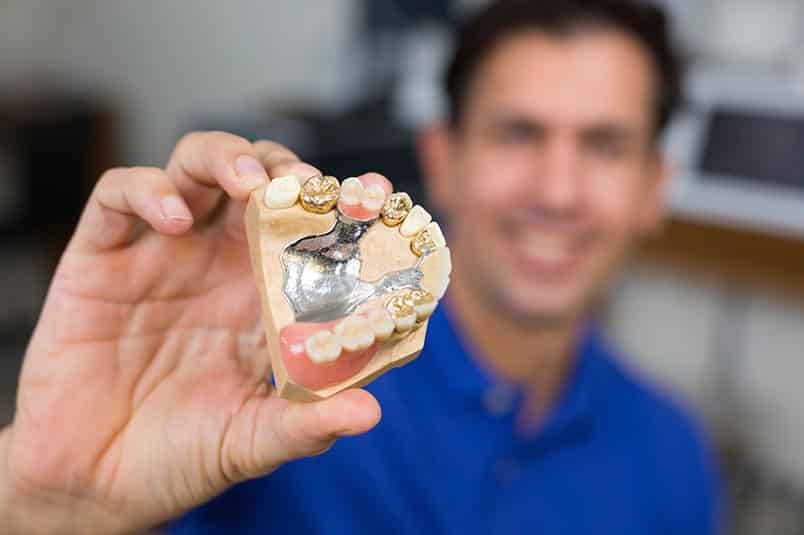
If some of your natural teeth have already been removed, you need a partial denture. Aptly named, partial dentures replace teeth when only some and not all are missing in either or both the upper and the lower jaw.
Why You Need a Partial Denture?
A partial denture enhances your appearance. Some people also opt for partial dentures to make chewing easier. Missing teeth means having spaces in between teeth and having the remaining teeth unsupported, making them over erupt or lean sideways. When this occurs, replacements become difficult. To remedy this, you should opt to put in partial dentures.
Partial dentures may support an opposing full denture. The opposing full denture in this case replaces all your lower or upper teeth. Suppose you have a full denture on your upper jaw and a few natural front teeth left on the lower part of your mouth. The problem is, when you bite or chew food, it may result in tilting down the back of the upper denture.
In this situation, it would be advisable to wear a partial denture to prevent unintentional damage on the remaining natural front teeth. A denture will make the strain produced by chewing and grinding become evenly distributed.
In the process, the wear and tear of the few remaining natural teeth becomes greatly minimised. Depending on your preference, your dental prosthetist can make you a partial denture using a variety of materials and designs.
Partial Denture Materials You Can Choose From
Partial dentures can be made from different materials – mostly acrylic, cast metal and nylon.
1. Acrylic partial dentures
These will cost you the lowest and are the most cost-effective. Further, your dental prosthetist (DP) may recommend these where there is significant tooth loss or in case your teeth need to be extracted. The advantage is that they are generally much easier to repair, reline or modify.
Though unnecessary in certain cases, most of these acrylic dentures have stainless steel or clasps for retention in the mouth.
2. Cast metal partial dentures
Most people prefer these cast metal partial dentures because they support the remaining natural teeth quite perfectly. You may also like their thinner and more appealing small size inside your mouth. They have a rigid frame that also lets you transfer bite impact to your remaining natural teeth.
This is possible because they have metal rests on the opposing surface of the supporting teeth. Cast metal retainers, tooth coloured resin or flexible nylon can be used as retention for a cast metal partial denture.
Your DP should advise you on the choice of retention that will work best for your dentures. Just like other dentures, metal partial dentures can be repaired or relined when necessary. Notice however that this may involve welding, so be sure to consult with your DP.
3. Nylon partial dentures
Flexible nylon partial dentures are made from thermoplastic nylon. They are often available in two different options that vary in rigidness. These dentures require no metal retainers. Because of this flexibility, their base is used to retain them in the socket.
They can also often be used with clear or tooth coloured resin retainers. The hassle from using nylon flexible partial dentures is if you need them relined or repaired. This usually takes at least a week. Ask your dental prosthetist for more information regarding your options.
What to Expect From Partial Dentures?
- Like with any new denture, new partial dentures may feel a little awkward or bulky in your mouth in the beginning. It’s important to understand that this is absolutely normal. You naturally become accustomed to wearing them eventually.
- Eating with new partial dentures should equally feel off at the beginning. But this will just be for a short period. You can start by eating soft foods cut into small pieces. Exercise your dentures by chewing on both sides of your mouth to exert even pressure on both sides. Also avoid foods that are extremely sticky as they may weaken your gum and affect how the dentures fit.
- It will take some patience and practice to insert and remove your partial denture. Fortunately, it won’t be long before you become a pro at it.
- You can expect soreness if your new partial denture puts too much pressure on a particular area. When this happens, check in with your DP. He or she will adjust the partial denture to fit more comfortably. You can also expect your DP to recommend taking out your partial dentures before you go to bed and put them back on in the morning. Be sure to put the dentures in some water so that they do not dry out.
- The partial denture should fit into place easily. You shouldn’t force it into position, not even by biting down. Such force could bend the clasps or break them all together.
- Your dental prosthetist DP will provide you with specific instructions on how long the denture should be worn and how often and for how long. Be sure to follow them to the letter so you can get the best results.
- You may be asked to wear your partial dentures continuously without taking them off. This will be a little uncomfortable. But this is the quickest way to pinpoint which parts may require adjustment.
- The partial denture may help you pronounce words better. You may realise that your speech becomes better as your mouth gets accustomed to the new dentures.
Conclusion
Do you have a missing tooth or a couple of missing teeth? Don’t hesitate in getting partial dentures to boost your confidence and have a new, better oral experience.











